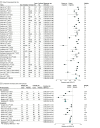Immunogenicity Rates After SARS-CoV-2 Vaccination in People With End-stage Kidney Disease: A Systematic Review and Meta-analysis
- PMID: 34709385
- PMCID: PMC8554642
- DOI: 10.1001/jamanetworkopen.2021.31749
Immunogenicity Rates After SARS-CoV-2 Vaccination in People With End-stage Kidney Disease: A Systematic Review and Meta-analysis
Abstract
Importance: Adults receiving dialysis treatment have a higher likelihood of death when infected with SARS-CoV-2 than adults not receiving dialysis treatment. To date, the immune response of people receiving dialysis after SARS-CoV-2 vaccination has not been systematically discussed.
Objective: To assess immunogenicity rates in people with end-stage kidney disease (ESKD) receiving SARS-CoV-2 vaccines, explore postvaccination potential risk factors for nonresponse, and assess whether receiving dialysis is associated with different antibody response rates compared with the nondialysis population.
Data sources: This systematic review and meta-analysis used articles from PubMed, Medline, and Embase published before July 30, 2021, as well as articles in the medRxiv preprint server.
Study selection: Studies that evaluated the immunogenicity rate according to the postvaccine antibody response rate in patients with ESKD receiving dialysis were selected.
Data extraction and synthesis: The meta-analysis was conducted according to the Preferred Reporting Items for Systematic Reviews and Meta-Analyses (PRISMA) guideline. A random-effects model was used. Two independent reviewers conducted the literature search and extracted the data.
Main outcomes and measures: The primary outcome was the pooled antibody postvaccine response rates in individuals with ESKD. The secondary outcomes were pooled response rates in individuals receiving and not receiving dialysis. Subgroup analysis and meta-regression were conducted to identify the sources of heterogeneity.
Results: A total of 32 studies were included. The overall immunogenicity rate of the dialysis group was 86% (95% CI, 81%-89%). Meta-regression showed a significant difference was detected in the postvaccine response rate on the basis of prevalence of diabetes (regression coefficient, -0.06; 95% CI, -0.10 to -0.02; P = .004). Compared with nondialysis controls, patients in the dialysis group had a lower response rate after the first (relative risk [RR], 0.61; 95% CI, 0.47-0.79; I2 = 70.2%) and second (RR, 0.88; 95% CI, 0.82-0.93; I2 = 72.2%) doses, with statistically significantly increased RR between first and second doses (P = .007).
Conclusions and relevance: These findings suggest that the immunogenicity rate among patients receiving dialysis was 41% after the first dose and 89% after the second dose. Diabetes might be a risk factor for nonresponse in the dialysis population. Patients receiving dialysis had a poorer antibody response rate than did individuals not receiving dialysis, particularly after the first dose.
Conflict of interest statement
Figures
References
Publication types
MeSH terms
Substances
LinkOut - more resources
Full Text Sources
Medical
Miscellaneous




